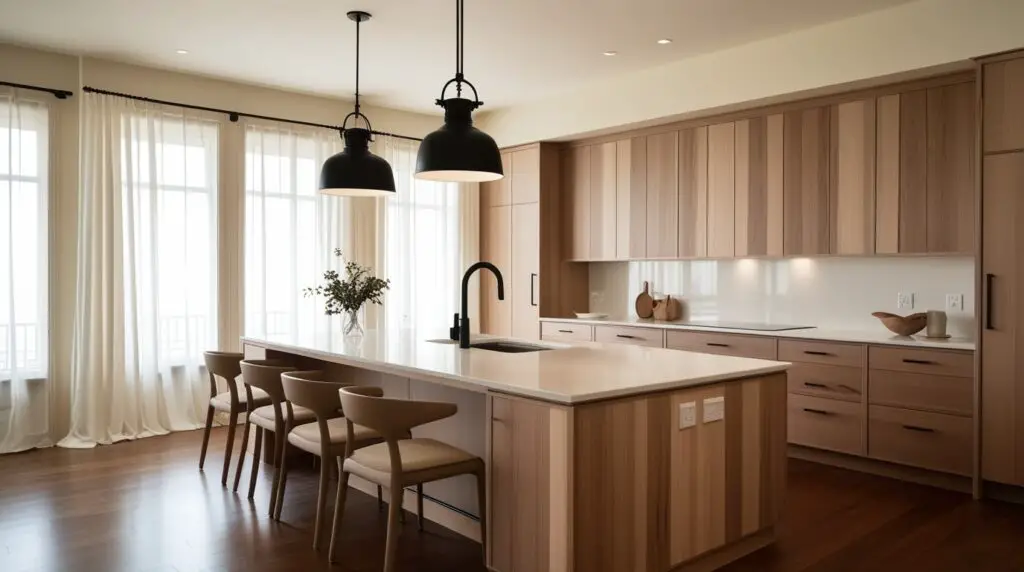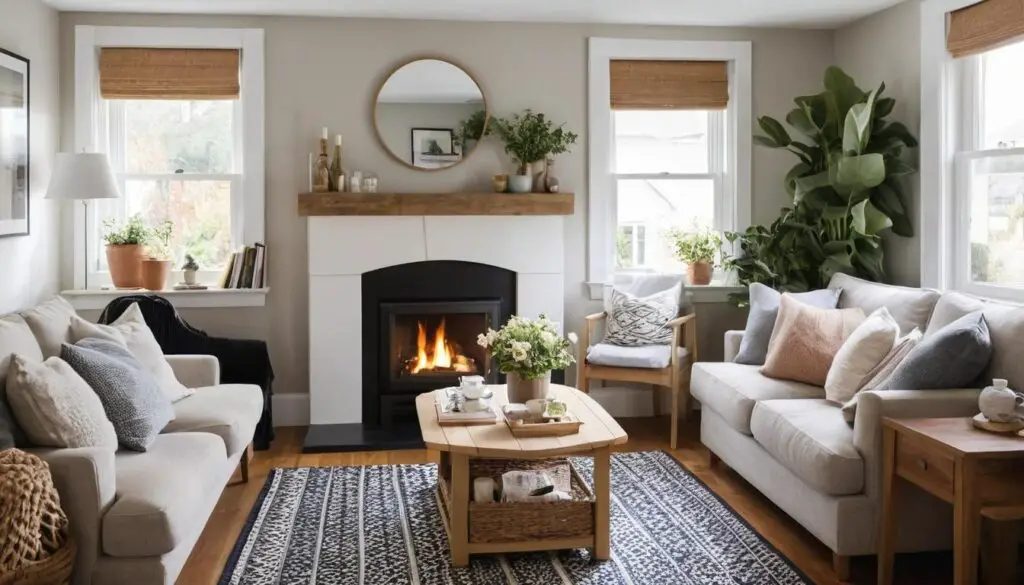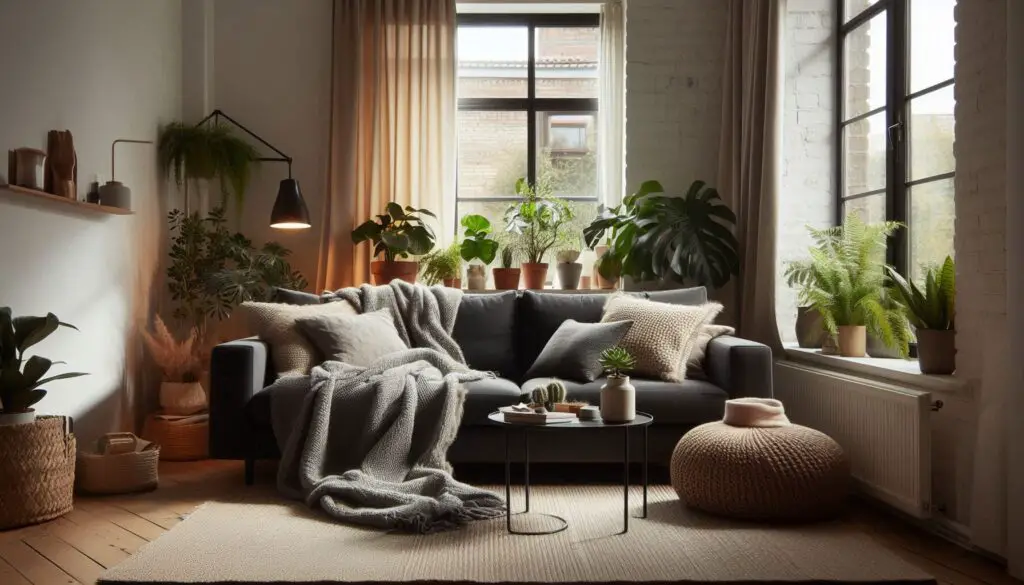Japandi style is all about blending the minimalism of Japanese design with the warmth of Scandinavian interiors. A Japandi Style kitchen is sleek, functional, and inviting, using natural materials, muted colors, and clean lines to create a serene space. If you love simplicity with a touch of warmth, these 15 Japandi kitchen ideas will inspire you to bring harmony into your home!
1. Neutral Color Palette
Japandi kitchens focus on soft, neutral tones like beige, taupe, gray, and warm whites to create a calming atmosphere. These hues keep the space looking fresh and airy.
How to Make It Happen
- Use off-white or light gray walls.
- Choose cabinetry in soft, natural wood tones or muted colors.
- Stick to a monochromatic look with subtle contrasts.
- Incorporate black or dark brown elements for depth.
Style Tip
Stick to earthy and muted shades to maintain a balanced and timeless look.
Picture This
Soft natural light filters into a kitchen with warm beige walls, light wood cabinets, and black hardware accents. A ceramic teapot sits on the counter, perfectly blending into the tranquil, neutral space. The room feels like a breath of fresh air—peaceful, refined, and effortlessly stylish.
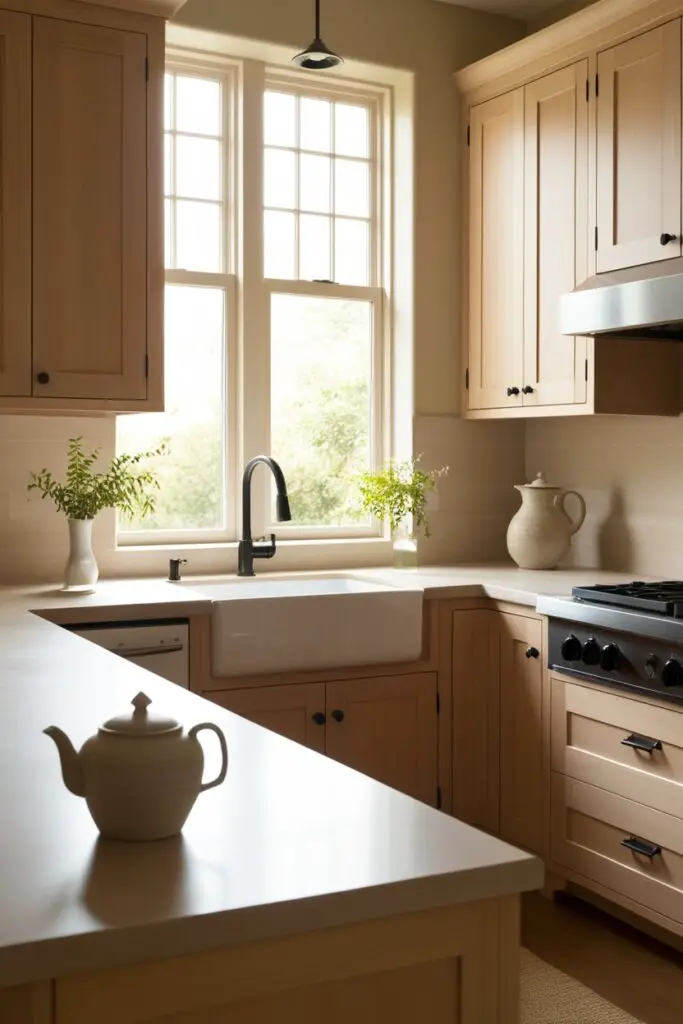
2. Natural Wood Accents
Wood is essential in Japandi design, adding warmth and an organic touch to the kitchen. From cabinetry to floating shelves, wood brings nature indoors.
How to Make It Happen
- Opt for light or medium-toned woods like oak, ash, or walnut.
- Install wooden floating shelves for open storage.
- Use wooden bar stools or a butcher block countertop.
- Add wood paneling or slatted wood details for texture.
Style Tip
Mix different wood tones subtly for a layered and natural effect.
Picture This
A kitchen island with a natural oak countertop sits at the center of the space, surrounded by soft wood cabinetry. Open wooden shelves display neatly arranged ceramic bowls, bringing warmth and function to the room. The overall feel is cozy yet uncluttered—like a perfect blend of simplicity and comfort.
3. Minimalist Cabinetry
Japandi kitchens embrace sleek, handleless cabinetry for a clean and seamless look. The focus is on simplicity and functionality.
How to Make It Happen
- Choose flat-panel cabinets with push-to-open mechanisms.
- Opt for matte finishes in neutral or wood tones.
- Keep storage streamlined to reduce visual clutter.
- Use built-in organizers for a tidy interior.
Style Tip
Matte or soft-touch finishes add a sophisticated yet understated feel to the kitchen.
Picture This
Cabinets with a smooth, handle-free design line the walls, blending seamlessly into the kitchen. Their soft, matte finish absorbs light, creating a cozy yet elegant atmosphere. A few carefully placed ceramic jars sit on the counter, keeping the space effortlessly stylish and clutter-free.
4. Open Shelving for an Airy Feel
Instead of upper cabinets, Japandi kitchens often feature open shelving to enhance openness and display beautiful dishware.
How to Make It Happen
- Install floating wooden shelves for a light, natural look.
- Display neatly arranged ceramics and glassware.
- Use woven baskets or stoneware containers for storage.
- Keep it minimal—only essential items should be on display.
Style Tip
Arrange items in small clusters for a balanced, harmonious feel.
Picture This
Simple wooden shelves hold handcrafted ceramic bowls, neatly stacked plates, and a small potted plant. Everything is arranged with care, creating a display that’s both practical and aesthetically pleasing. The absence of upper cabinets makes the space feel open, breathable, and effortlessly elegant.
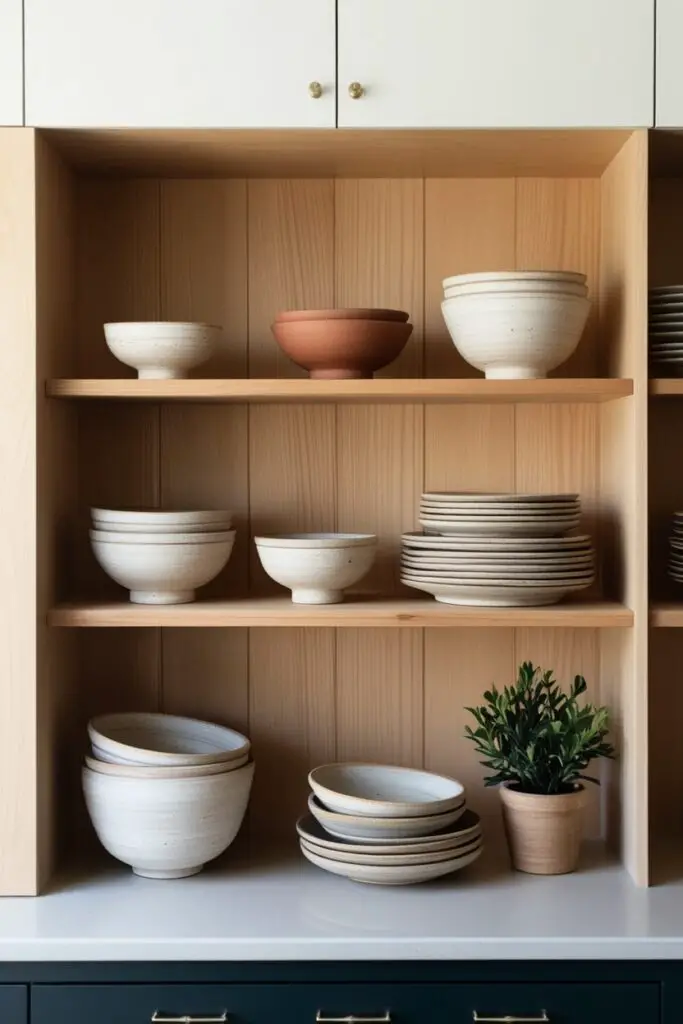
5. Concrete or Stone Countertops
Natural materials like stone and concrete add an organic yet sophisticated element to a Japandi kitchen.
How to Make It Happen
- Choose quartz, soapstone, or concrete for durability.
- Keep the color palette neutral with earthy grays and warm beiges.
- Pair stone countertops with wooden cabinetry for balance.
- Opt for a matte or honed finish for a natural touch.
Style Tip
A slightly textured surface adds depth and character without feeling overwhelming.
Picture This
A sleek concrete countertop extends across the kitchen, its soft gray tone complementing the warm wooden cabinetry below. The surface feels cool to the touch, contrasting beautifully with the organic textures of ceramic dishware and linen napkins. The overall vibe? Effortlessly modern yet deeply inviting.
6. Subtle Black Accents
A touch of black adds depth and contrast to a Japandi kitchen without overwhelming its soft, natural aesthetic.
How to Make It Happen
- Use black metal handles, faucets, or pendant lights.
- Incorporate black-framed glass cabinets for a modern touch.
- Choose black bar stools or open shelving brackets.
- Keep black elements minimal to maintain balance.
Style Tip
Matte black finishes add sophistication without overpowering the space.
Picture This
A Japandi kitchen with soft wood tones and creamy walls, accented by sleek black pendant lights over the island. The black faucet contrasts beautifully with the light stone countertop, adding a touch of elegance while keeping the space grounded and modern.
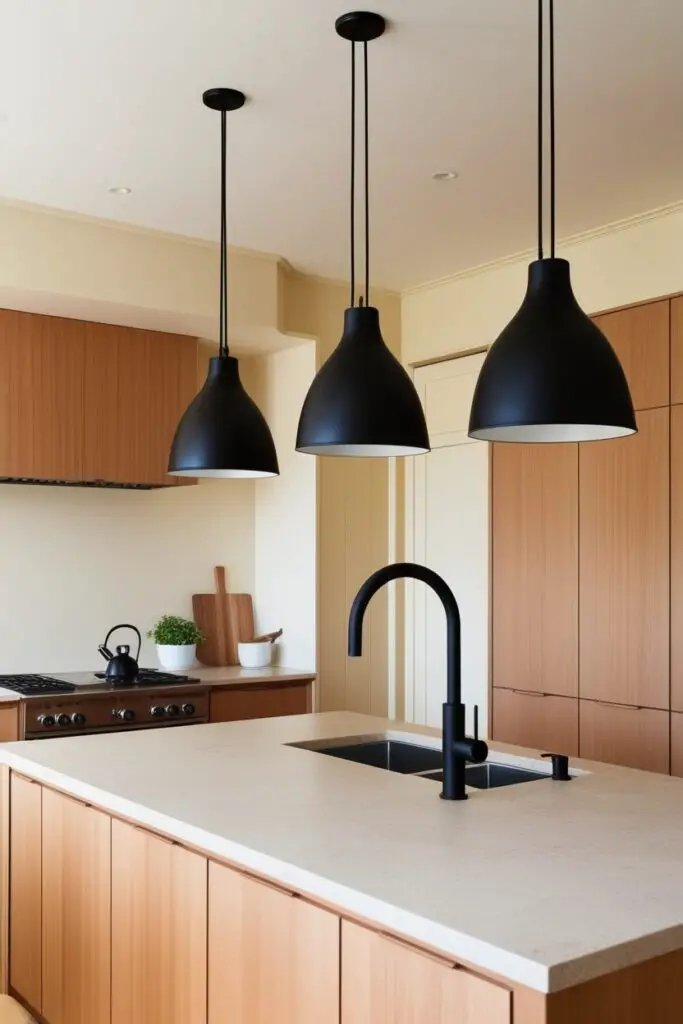
7. Soft Ambient Lighting
Lighting plays a key role in creating a warm, inviting Japandi atmosphere. A mix of natural and soft artificial lighting enhances the overall coziness.
How to Make It Happen
- Install pendant lights with natural fiber or glass shades.
- Use recessed lighting for a seamless look.
- Add under-cabinet LED strips for subtle illumination.
- Incorporate floor or table lamps with paper or linen shades.
Style Tip
Warm white bulbs create a soft glow that enhances Japandi’s cozy aesthetic.
Picture This
A kitchen bathed in warm, golden light from woven pendant lamps, casting gentle shadows on the natural wood cabinetry. The subtle glow from under-cabinet lights highlights the stone countertops, making the space feel peaceful and welcoming.
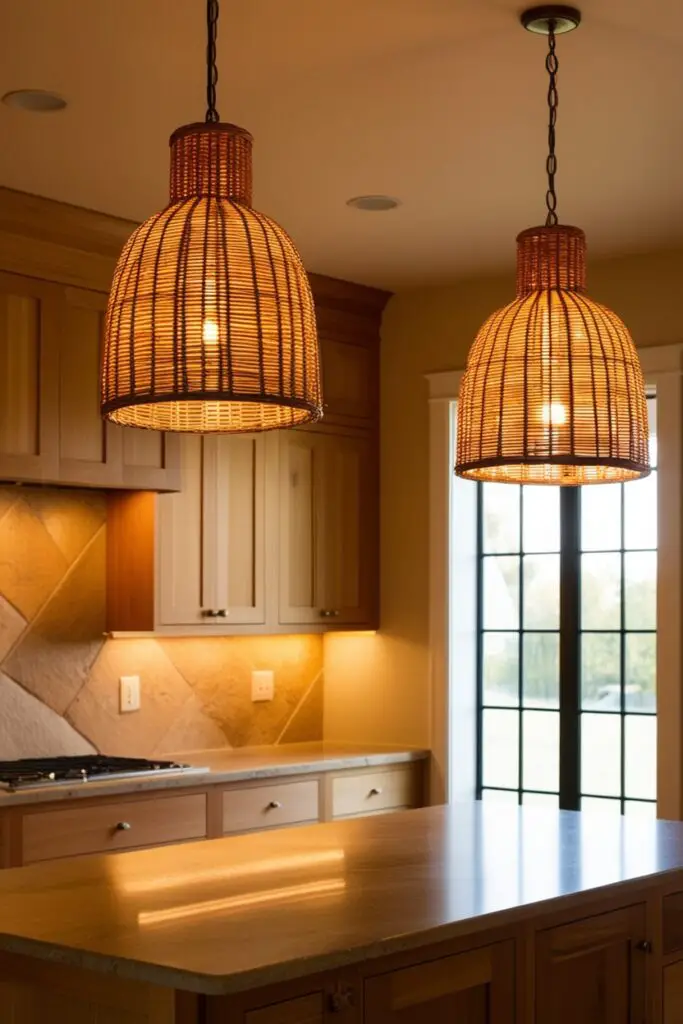
8. Open Shelving with Natural Elements
Open shelves bring an airy, minimalist feel while showcasing beautiful dishware and natural textures.
How to Make It Happen
- Install light wood floating shelves.
- Display ceramic dishes, stoneware, and wooden bowls.
- Keep styling minimal with neutral tones and greenery.
- Use hidden storage to maintain a clutter-free look.
Style Tip
Limit displayed items to essentials to keep the space calm and harmonious.
Picture This
A serene kitchen with floating wooden shelves holding handmade ceramic plates, woven baskets, and a touch of greenery. Sunlight filters in, highlighting the simplicity and balance of natural elements.
9. Low-Profile, Handleless Cabinets
Japandi design embraces sleek, handleless cabinets for a clean, seamless look. This creates an uncluttered and modern aesthetic that feels both functional and elegant.
How to Make It Happen
- Opt for push-to-open or recessed-handle cabinets.
- Choose soft-close mechanisms for a smooth experience.
- Stick to natural wood or matte finishes for warmth.
- Keep cabinetry flush for a seamless flow.
Style Tip
Matte finishes work best for a modern yet organic feel.
Picture This
A kitchen with sleek, handle-free cabinets in soft oak, perfectly aligned for a seamless, uninterrupted design. The smooth matte finish reflects gentle light, making the space feel effortlessly elegant and peaceful.
10. Earthy and Neutral Color Palette
A Japandi kitchen thrives on warm, muted tones that create a calming and inviting environment. Think soft beiges, warm whites, and earthy grays.
How to Make It Happen
- Use light wood cabinetry paired with off-white walls.
- Add taupe or soft gray countertops for subtle contrast.
- Incorporate natural fabrics like linen for decor.
- Avoid bold colors to maintain a tranquil feel.
Style Tip
Stick to a limited color palette for a cohesive, balanced look.
Picture This
A kitchen wrapped in warm beige tones with creamy walls and light wooden cabinetry. The soft gray stone countertop adds a gentle contrast, enhancing the organic warmth of the space.
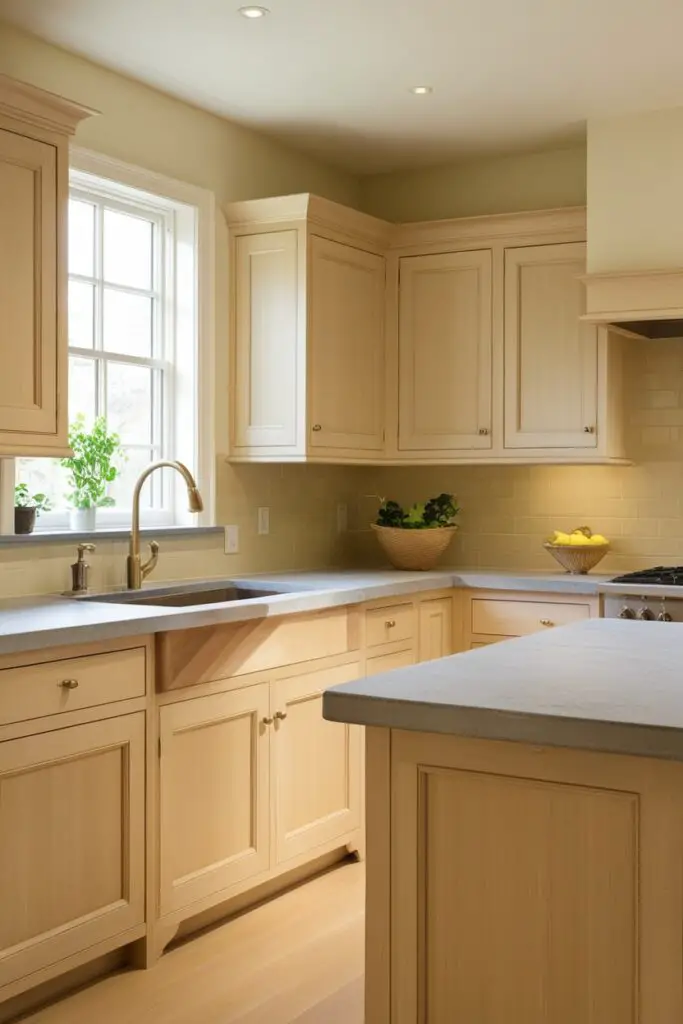
11. Textured Backsplash with a Handmade Feel
A textured backsplash, such as handcrafted tiles, adds depth and a subtle artisanal touch to a Japandi kitchen.
How to Make It Happen
- Choose handcrafted subway or zellige tiles.
- Stick to neutral, earthy hues like cream, beige, or soft gray.
- Opt for a matte or slightly uneven surface for character.
- Pair with simple, understated grout lines.
Style Tip
A slightly imperfect, handmade look enhances warmth and personality.
Picture This
A backsplash of softly textured, off-white tiles reflecting the afternoon light, with each tile slightly unique in its shape and glaze. It adds a quiet charm without overwhelming the serene kitchen aesthetic.
12. Built-In or Minimalist Range Hood
Instead of a bulky hood, a built-in or streamlined option blends seamlessly into a Japandi-style kitchen for a subtle, elegant look.
How to Make It Happen
- Choose a hidden or integrated range hood.
- If exposed, keep it sleek and simple in wood or white.
- Avoid excessive ornamentation or metal detailing.
- Ensure ventilation is effective while maintaining aesthetics.
Style Tip
A slim, neutral-toned hood keeps the space cohesive and open.
Picture This
A sleek, built-in range hood seamlessly blending into the light wood cabinetry, barely noticeable yet perfectly functional. The design maintains the kitchen’s clean, harmonious flow without distractions.
13. Functional and Stylish Kitchen Island
A Japandi kitchen island is not just a workspace but also a gathering point, designed for simplicity and function.
How to Make It Happen
- Use natural wood or a warm, neutral stone countertop.
- Keep the design streamlined without excessive ornamentation.
- Add bar stools with organic materials like rattan or linen.
- Maintain ample space around the island for easy movement.
Style Tip
Opt for rounded edges to soften the island’s look.
Picture This
A minimalist oak kitchen island with a creamy quartz top, paired with woven rattan stools. The space feels open and inviting, perfect for casual dining or meal prep in a peaceful setting.
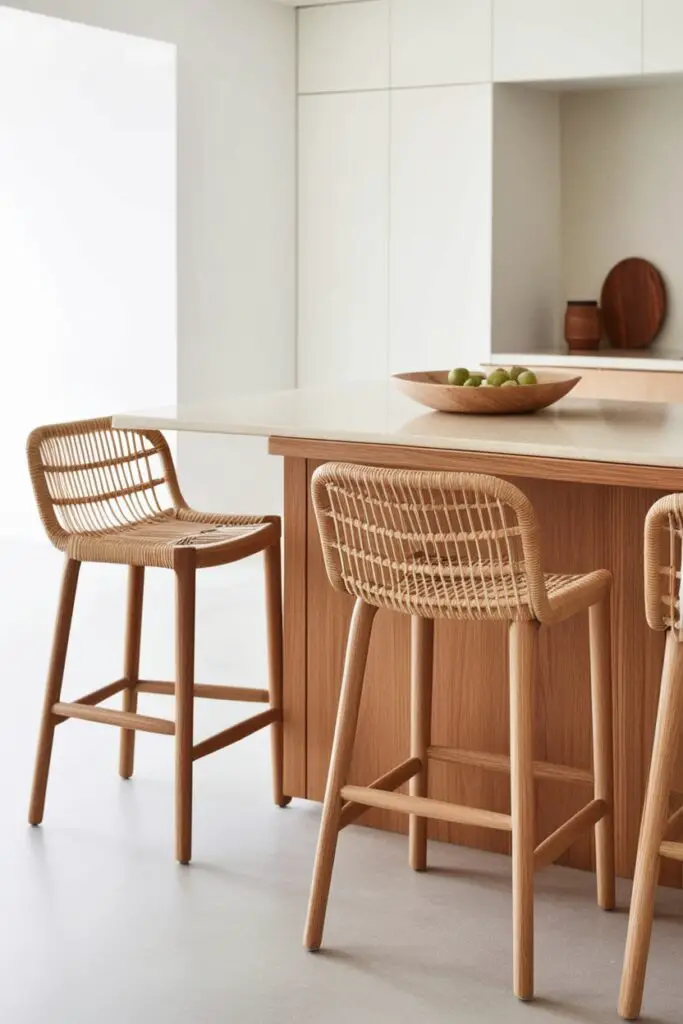
14. Thoughtfully Placed Greenery
Adding greenery brings life to a Japandi kitchen, reinforcing the connection to nature while keeping the space fresh and inviting.
How to Make It Happen
- Use small potted plants like herbs or succulents.
- Place a single leafy branch in a ceramic vase.
- Opt for low-maintenance greenery to keep it effortless.
- Avoid excessive florals or bright-colored plants.
Style Tip
Stick to muted greens like olive or eucalyptus for a soft touch.
Picture This
A simple ceramic vase with delicate eucalyptus branches placed on the kitchen counter, bringing a hint of nature into the space. A small herb planter sits by the window, basking in the soft daylight.
15. Sustainable and Natural Materials
Japandi design values sustainability, making natural, eco-friendly materials a must for a thoughtfully designed kitchen.
How to Make It Happen
- Use reclaimed wood for cabinetry or shelving.
- Opt for stone or quartz countertops with a natural finish.
- Choose eco-friendly paints and low-VOC finishes.
- Incorporate bamboo, linen, and rattan in decor elements.
Style Tip
Prioritize high-quality, durable materials that age beautifully.
Picture This
A kitchen adorned with ethically sourced wooden cabinetry, soft linen curtains swaying in the breeze, and a rattan pendant light casting a warm, inviting glow. Every element feels intentional, natural, and timeless.
Conclusion
A Japandi-style kitchen blends the warmth of Scandinavian coziness with the elegance of Japanese minimalism, creating a peaceful, functional space. By focusing on natural materials, soft lighting, and subtle contrasts, you can craft a kitchen that feels timeless and inviting.
Whether you’re embracing open shelving, soft textiles, or sustainable choices, each element contributes to a harmonious, clutter-free atmosphere. The key is balance—keeping the space simple yet warm, minimal yet full of character. With these japandi style kitchen ideas, you can turn your kitchen into a serene retreat that makes cooking and gathering a truly enjoyable experience.

